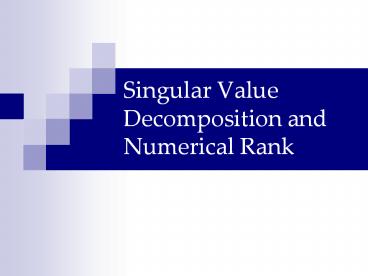Singular Value Decomposition and Numerical Rank - PowerPoint PPT Presentation
Title:
Singular Value Decomposition and Numerical Rank
Description:
Singular Value Decomposition and Numerical Rank The SVD was established for real square matrices in the 1870 s by Beltrami & Jordan for ... – PowerPoint PPT presentation
Number of Views:161
Avg rating:3.0/5.0
Title: Singular Value Decomposition and Numerical Rank
1
Singular Value Decomposition and Numerical Rank
2
- The SVD was established
- for real square matrices in the
1870s by Beltrami Jordan - for complex square matrices by
Autonne - for general rectangular matrices by
Eckart Young - (autonne-Eckart-Young theorem)
- Theorem
- Let . Then there exist
orthogonal unitary matrices - and
such that - where
- and
with
3
- Since , we have
. Denoting by - we can arrange
that
. Let be a
corresponding set of orthonormal eigenvectors and
let - Then if we
have - where
- Also so that
- and thus
- Let . Then from we
have - Choose any such that
is orthogonal. - Then
- and so as desired.
4
- The numbers together with
are called the
singular values of and they are positive
square roots of the eigenvalues (which are non
negative) of . - The columns of are called the left singular
vector of (the orthonormal eigenvectors of
) while the columns of
are called the right singular vector of
(the orthonormal eigenvectors of
). - The matrix has singular
values, the positive square roots of the
eigenvalues of . The - nonzero singular
values of and are the same.
5
- It is not generally a good idea to compute the
singular values of by the first finding the
eigenvalues of , tempting as that is. - Ex Let be a real number with
(so that ) - Let
- Then
- so we compute
leading to the (erroneous) conclusion that the
rank of is 1. - If we could compute in infinite precision, we
would have - with and thus
. - The point is that by working with we
have unnecessarily introduced into the
computation.
6
- It is clear from the definition that the number
of nonzero singular values of determines
its rank while the question is not nearly
clear-cut in the context of computation on a
digital computer, it is now generally
acknowledged that the singular value
decomposition is the only generally reliable
method of determining rank numerically. ---------
look at the smallest non-zero singular value of
a matrix . - Since that computed value is exact for a matrix
near , it makes sense to consider the rank of
all matrices in some -ball (w,r,t. the
spectral norm say) around . - The choice of may also be based on
measurement errors incurred in estimating the
coefficients of or the coefficients may be
uncertain because of round off errors incurred in
a previous computation to get them. - The key quantity in rank determination is .
7
- The smallest nonzero singular value gives a
dependable measure of how far (in the
sense) a matrix is from matrices of lesser rank. - But alone is clearly sensitive to scale so
that a better measure - is . But so the
important quantity is which - turns out to be the reciprocal of the number
, the so-called
conditional number of A w.r.t. pseudo inversion. - In the case when A is invertible,
is usual spectral condition number
w.r.t. inversion. - Ref Stewart On the pertubation of
pseudo-inverses, projections, and linear least
squares problems, SIAM Review, vol.19,
pp.634-662, 1977. - In solving the linear system , the
condition number - gives a measure of
how much errors in A and/or may be
magnified in the computed solution. Moreover, if
, gives a measure of the
nearness of A to singularity.
8
- In fact measures the nearness of A
to singularity in any matrix norm and
for certain norms it is easy to construct
explicitly a matrix E with - and AE
singular. - Ex Consider the matrix
- is, in fact, very near singular and gets
more nearly so as n increases. - Adding to every element in the
first column of A gives an exactly singular
matrix. - Rank determination, in the presence of round off
error, is a highly nontrivial problem.

